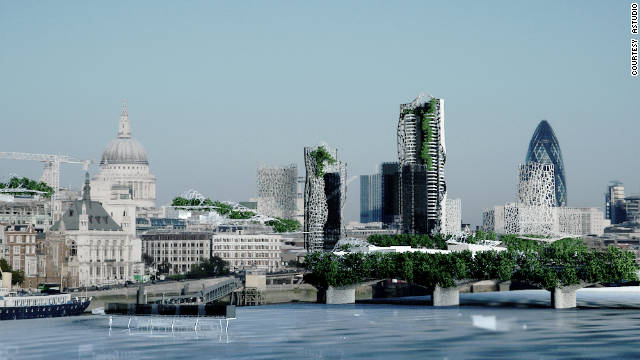
A graphical representation of Londons living skyline as envisaged by award-winning architect Richard Hyams.
by Bea Kylene Jumarang
These days, words like protocell belong in biology laboratories. Even words like carbon cycle confuse the majority of people. Still, you may be asking, why is protocell being described in relation to architecture?
In biology, and as Biology-Online puts it, a protocell is a large, ordered structure enclosed by a membrane, which carries out life activities, such as growth and division. In any case, perhaps the only word you need to take away is the word activities. Why?
In short form, the next wave of architecture will involve making buildings come alive. Ergo, buildings will do things, instead of just being there. While this paragraph sounds like something straight out of a science fiction, but give me a moment.
Synthetic protocell biology or SPB, a term coined by researchers from the Complex Systems Laboratory of the Catalan Institute for Research and Advanced Studies (ICREA-CSL) aims at the construction of a chemical life-like ensemble to form an artificial cell system able to self-maintain, self-reproduce and potentially evolve. (Sole, Munteanu, et. al, 2007)
It is in this framework that we can place the work of Dr. Rachel Armstrong, a British senior fellow at TED and co-director of Avatar, a research group involved with exploring the potentials of advanced technology in the field of architecture. According to her, living buildings could be programmed to extract carbon dioxide from the air; an approach that could be adopted massively in cities over the next forty years.
Dr. Armstrong cites chemicals that she terms protocells that are engineered to behave biologically and are manipulable in terms of the things they can do. Such biological creations could help fill gaps with regard to the tasks nature simply cannot perform. In this respect, creating chemicals that behave as such is an exercise in synthetic biology.
Protocell technology matters because of what it can potentially do. Presently, we are facing worrying statistics – over 33.5 billion metric tons worth of carbon emissions in 2010, half of which goes direct to the atmosphere while 26% goes to land and 24% to our oceans; this other half becomes part of what’s called the carbon sink.
Given such data, it’s clear that action needs to be taken. In the bigger picture, developing protocells is a partial fix. Still, it’s something that works toward a solution.
As Dr. Armstrong postulates, protocells could be mixed into paint and programmed to create limestone when they come into contact with carbon dioxide. Limestone, a natural by-product of the carbon cycle, is a valued industrial substance.
In view of that, a protocell is environmental technology at its finest. Not only would it create something of value (limestone), but it would also help alleviate the destructive power of carbon dioxide emissions. In addition Armstrong theorizes that the limestone could thicken, forming somewhat natural insulation for buildings. This of course would reduce heating requirements and therefore lower carbon emissions from power plants.
More than that, the British scientist also says that such protocell-produced limestone could heal a building’s micro-fractures, akin to how the body can heal its own wounds.
As of the present though, Dr. Armstrong admits that such technology is in its infancy. The research and industrial changes needed to accommodate protocells are still vast. However, the technology itself is promising; something that puts human ingenuity to work for a world that desperately needs a helping hand.
References
Boden, T. and Blasing, T.J. “Record High 2010 Global Carbon Dioxide Emissions from Fossil-Fuel Combustion and Cement Manufacture.” CDIAC. Carbon Dioxide Information Analysis Center, n.d. Web. 15 Jun 2012. <http://cdiac.ornl.gov/trends/emis/prelim_2009_2010_estimates.html>
Groff, E.. “How human activities affect the carbon cycle.” Phys.Org. Phys.Org, 2010. Web. 15 Jun 2012. <http://phys.org/news/2010-12-human-affect-carbon.html>
Rogers, S. and Evans, L. “World carbon dioxide emissions data by country.” The Guardian. The Guardian, 31 Jan 2011. Web. 15 Jun 2012. <http://www.guardian.co.uk/news/datablog/2011/jan/31/world-carbon-dioxide-emissions-country-data-co2>
Sole, R. and Munteanu, A. et al. “Synthetic Protocell Biology: From Reproduction to Computation.” Philosophical Transactions of the Royal Society B: Biological Sciences. Philosophical Transactions of the Royal Society B: Biological Sciences, 01 May 2007. Web. 15 Jun 2012. <http://rstb.royalsocietypublishing.org/content/362/1486/1727.full.pdf html>
Webster, G. “Living buildings could inhale city carbon emissions.” CNN.com. Cable News Network (CNN), 14 Oct 2011. Web. 15 Jun 2012. <http://edition.cnn.com/2011/10/14/tech/innovation/living-buildings-carbon/index.html>

Comments are closed.